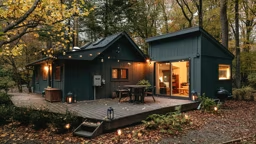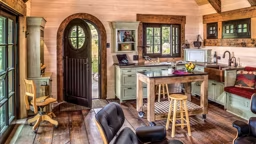
- Pros: Fiber-cement siding provides a traditional wood grain appearance that will not warp, crack, buckle, or fade. It’s also resistant to fire, weather and insects – and will hold paint for three times as long as conventional wood siding (often up to 15 years). Cons: Like any siding product, this material can be vulnerable to moisture invasion if the product is not factory primed or sealed to protect from mold.
- Availability: Local and nationwide delivery available.
- Price range: Typically costs 37 percent less than cedar and 24 percent less than wood siding. Three factors affect the price: materials, labor, and paint or stain being applied.
- For more info: www.cement.org/homes/ch_bs_fibercement.asp.

2. Rustic or Aged Steel. Rustic metal siding offers a unique look that will make your cabin stand out from your neighbors, and it comes in many different looks. The siding shown comes from Bridger Steel, which produces Cor-ten, cold rolled, copper, galvanized, bonderized and many other custom profiles and trim options to suit your needs.
- Pros: Energy efficient, durable, long-lasting; little-to-no maintenance; 100-percent recyclable. Cons: Material is sharp so installer needs to be extra careful.
- Availability: Local and nationwide delivery available.
- Price range: Varies depending on product.
- For more info: www.bridgersteel.com.

3. Painted Steel. Painted steel siding offers dynamic, eye-catching appeal. The siding shown comes from Bridger Steel, which offers over 26 colors from which to choose.
- Pros: Energy efficient, durable, long-lasting; little-to-no maintenance; 100-percent recyclable. Cons: Material is sharp so installer needs to be extra careful.
- Availability: Local and nationwide delivery available.
- Price range: Varies depending on product.
- For more info: www.bridgersteel.com.
4. Cedar Log Siding. Lightweight, slow growing and naturally durable, cedar produces long lengths of timber with true, straight grain. Siding shown is from Modulog, which uses western cedar, one of North America’s great renewable resources. In addition, 75-percent less wood is used in Modulog log packages than in a traditional log home.
- Pros: Cedar log siding is resistant to decay, shrinkage, warping, and twisting. Plus, cedar’s low density makes it a great thermal insulator. Cons: Because everything is custom-cut, it takes 30 days to ship.
- Availability: Can be shipped to any location in the U.S. or Canada within 30 days.
- Price range: The average custom designed package for a single-story, 3-bedroom house is $10,000-$12,000 (does not include installation or shipping).
- For more info: www.modulog.com.

5. Reclaimed Wood. An ideal choice for folks who appreciate the uniqueness of each timber, reclaimed wood siding comes from first-growth wood, which is very stable from centuries of air drying and is of higher quality than second-growth lumber. In addition, the grain of the old-growth is much tighter due to its slow rate of growth in the ancient forest. The siding shown comes from Heritage Restorations, which offers wood in different species, as wells as many different looks, including red crackle paint finish, rough sawn brown, and weathered gray.
- Pros: Reclaimed wood provides natural, textural, eco-friendly elements. Every board foot of recycled wood used is a board foot saved from the live forest, as well as the fuel saved from kiln-drying the wood, and the landfill space saved that would be used to dispose of the reclaimed wood. Cons: Reclaimed wood siding costs more than some other siding options.
- Availability: Although it is a finite resource, many different species of reclaimed wood are still available such as pine, oak and hemlock. Wide planks from 12 to 20 inches wide are available, which won’t be found in new milled lumber.
- Price range: Price depends on the final materials chosen, but typically the cost will run between $3 to $6 per board foot.
- For more info: www.heritagebarns.com.
When trying to settle an argument, frequent contributor Christy Heitger doesn’t like to pick sides. Picking siding options for the cabin, however, is loads of fun.










